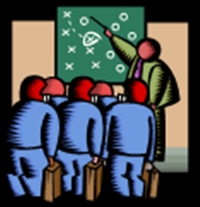5 Tips for Making Smart Marketing Decisions
By Bob Hougland
Just about every business is impacted in some way during challenging times, but businesses often lack the wiggle room to adapt. Consider the following as you look at your own situation:
1. Don’t make hurried, short-term decisions.
In a financial crunch, businesses often slash or eliminate expenses for things they can “do without.” In most cases, this can prove to be a short-term action with detrimental long-term consequences. First, if it’s something you can truly do without, it’s not likely that you would have been paying for it all along. Second, if you cut or eliminate something just  to save money without considering the impact on your overall operations, you’re selling yourself short. Rather than drop anything completely, consider reducing your expenditures in several areas to achieve the necessary economy. Consider involving at least your key people, if not your entire staff, in discussion of economization. You may be surprised by some of the ideas they have, and you’ll help maintain morale if they understand your situation and are given the opportunity to kick in their thoughts.
to save money without considering the impact on your overall operations, you’re selling yourself short. Rather than drop anything completely, consider reducing your expenditures in several areas to achieve the necessary economy. Consider involving at least your key people, if not your entire staff, in discussion of economization. You may be surprised by some of the ideas they have, and you’ll help maintain morale if they understand your situation and are given the opportunity to kick in their thoughts.
2. Don’t try to take up all the slack.
Part of the entrepreneurial spirit is rolling up your sleeves and doing whatever needs to be done. That’s certainly a viable position in difficult times, but don’t let it go too far. Your job is to stay focused on the big picture and to guide your company into the future, and you can’t do that if you’re bogged down for extended period in day-to-day details. Maintain your position at the helm, but pitch in where you can be most effective. Also, make sure that time-consuming activities are being performed by someone at the lowest appropriate cost-per-hour.
3. Tweak, rather than slash, your marketing program.
Over the years, I’ve seen countless companies dramatically curtail or even drop some or all of their marketing plans when finances are tight. Most often, I’ve seen advertising cut or even stopped entirely. That’s a false economy. First, there are still prospects and customers out there. That means opportunities to develop your existing accounts and generate new accounts out of what remains of your market. As some of your non-accounts become dissatisfied with their present suppliers because of cutbacks that competitor has made, they become qualified prospects for you. You need to maintain your presence in the marketplace and demonstrate your stability and reliability under any market conditions. Second, your competitors are still in place, and they will react to changes in the economy in various ways. Some will cut their advertising or reduce their services. Others will bite the bullet and maintain their marketing activities. Either way, don’t lose sight of the reality that you need to maintain your slice of the pie (i.e., your market share) regardless of the size of that pie, and you can actually carve out a bigger slice in down times by acquiring new accounts from your competitors. So, what about advertising? You can economize on advertising by decreasing your frequency. If you’re running an ad every week or every month, drop back to every other week or month. Cutting your frequency in half doesn’t cut your impact in half, and some people may not even notice the difference. Take a critical look at where you’re advertising. It’s likely that all of the media you are using aren’t equal in their penetration of your most important kinds of prospects, so make larger cuts among the least effective media. Don’t drop any one ad medium entirely since multi-media advertising is proven to provide the most bang for your buck. Cut back on each medium, but keep all in play. Also, maintain your memberships in trade associations and other organizations which get you and your company exposure. Continue to be seen and heard by your marketplace. Look for new opportunities to be interviewed or to publish articles in your area of expertise. That kind of exposure can have greater impact than paid advertising.
4. Keep your sales program alive.
One of my active clients has begun picking up some new accounts in recent weeks because a competitor has pulled his sales force off of all accounts below a certain dollar value and has ordered his sales staff to cut their travel in half. Some of their customers have reacted with resentment at not being seen as “important enough,” while others see a loss of the former level of customer service. Yes, some limits on travel can probably be made, but don’t do anything drastic which will be seen by your marketplace as pulling back. Your customers will understand less frequent sales calls, especially with the cost of gas. Keep your sales incentives in place and discuss with your sales staff the tactics and appeals to win over new customers from among those becoming dissatisfied with one of your competitors. Rather than dropping your prices, consider premiums or freebees to add value to your transactions.
5. Do seize on the opportunity to prepare for the future.
Take a step back with a critical look at your operation. Are you really organized for peak performance and optimum efficiency? Are there improvements you could make that will better your bottom line permanently? I remember from my military officer training that they stressed the best decisions are those which are made calmly and rationally before the  need to implement them arises. Are your difficulties in dealing with a slow market perhaps due to your lack of advanced contingency planning? Business, like the economy, always goes in cycles. How well have you already prepared for a down cycle? Often, job descriptions have evolved from the skills of the people in the particular positions rather than from the functional needs of the business. Are you set up on a strict, vertical department basis? That may work, but you may also be missing opportunities to improve your overall processes so that there is better coverage of an entire process during a temporary or permanent absence. Have you effectively delegated both authority and accountability? If not, you’re missing an important means of optimizing your company’s performance. If you don’t have a Business Plan or Marketing Plan, create one now. Why? Studies have shown that we’re all most careful about what we commit to paper. A documented plan gives you a roadmap through good and bad times by making you think through your activities. General Eisenhower said that the planning for D-Day in WWII was obsolete when the attack was actually launched, but that it was all of the thinking and discussion that went into the plan that prepared our forces for victory.
need to implement them arises. Are your difficulties in dealing with a slow market perhaps due to your lack of advanced contingency planning? Business, like the economy, always goes in cycles. How well have you already prepared for a down cycle? Often, job descriptions have evolved from the skills of the people in the particular positions rather than from the functional needs of the business. Are you set up on a strict, vertical department basis? That may work, but you may also be missing opportunities to improve your overall processes so that there is better coverage of an entire process during a temporary or permanent absence. Have you effectively delegated both authority and accountability? If not, you’re missing an important means of optimizing your company’s performance. If you don’t have a Business Plan or Marketing Plan, create one now. Why? Studies have shown that we’re all most careful about what we commit to paper. A documented plan gives you a roadmap through good and bad times by making you think through your activities. General Eisenhower said that the planning for D-Day in WWII was obsolete when the attack was actually launched, but that it was all of the thinking and discussion that went into the plan that prepared our forces for victory.
Look at economic changes as opportunity rather than a problem. A glass-half-full approach will get you farther than a glass-half-empty start.
Permission is needed from Lighthouse Consulting Services, LLC to reproduce any portion provided in this article. © 2014
Bob Hougland holds a BA in Psychology and is a Vietnam vet with almost 5 years’ USAF active duty. He began his business career in the fast-track executive development program at AT&T, but sought out smaller employers. For most of a decade, he held sales management positions at L.A. radio stations KIIS, 93KHJ, and K-EARTH101, and created a successful marketing consulting division for RKO General Radio. With both sales management and marketing management awards under his belt, he founded RGH MARKETING. He now is the Owner/Consultant at SuperTemp where he continues his career of helping good organizations be better, new ones to get off the ground and bringing some back from the brink of failure. He is a strategist who sees opportunities where others see problems and bring lessons learned in a wide range of industries to bear on new situations. He can be reached at 803-774-7777 or SuperTemp@pacbell.net or you can read his blog at http://businessguy.biz/.
Inspiration and Techniques for Building Championship-Level Performance – Lighthouse clients have one thing in common – all are committed to boosting the performance of their organizations. So, we are pleased to introduce our clients and friends to Boaz Rauchwerger — speaker, trainer, author and consultant. We highly recommend Boaz to you. Ask him to deliver one of his inspirational programs at your next executive retreat or strategic planning session.
One of our favorite Boaz programs is “Playing Like a Championship Team Every Day”. It helps you build on the strengths of everyone’s individual differences. This program helps you discover five steps to get everyone to join the building crew and resign from the wrecking crew. This is a very powerful and inspirational program that receives rave reviews every time.
• Master five techniques to inspire others to perform like champions
• Six recognition techniques including the powerful “good finder” program
• Learn four ways that your team can gain a competitive advantage
• Identify the three prerequisites for maximizing the team’s results
• Learn the two forms of keeping a daily score so everyone wins
Who is Boaz? Over a 30-year span, Boaz, author of The Tiberias Transformation – How To Change Your Life In Less Than 8 Minutes A Day, has conducted thousands of seminars internationally on goal setting and high achievement. He has taught over half a million people how to supercharge their lives, their careers and how to add Power to their goals. His innovative program, for individuals and corporations, is a simple and highly effective process for high achievement. He was voted Speaker of the Year by Vistage, an international organization of CEOs and business owners. How to Contact Boaz – Want more information on Boaz’s Power Program, including “Playing Like a Championship Team Every Day”? Just click here and we’ll be in touch.
If you would like additional information on this topic or others, please contact your Human Resources department or Lighthouse Consulting Services LLC, 3130 Wilshire Blvd., Suite 550, Santa Monica, CA 90403, (310) 453-6556, dana@lighthouseconsulting.com & our website: www.lighthouseconsulting.com.
Lighthouse Consulting Services, LLC provides a variety of services, including in-depth work style assessments for new hires & staff development, team building, interpersonal & communication training, career guidance & transition, conflict management, 360s, workshops, and executive & employee coaching. Other areas of expertise: Executive on boarding for success, leadership training for the 21st century, exploring global options for expanding your business, sales and customer service training and operational productivity improvement.
To order the books, “Cracking the Personality Code” and “Cracking the Business Code” please go to www.lighthouseconsulting.com.





















